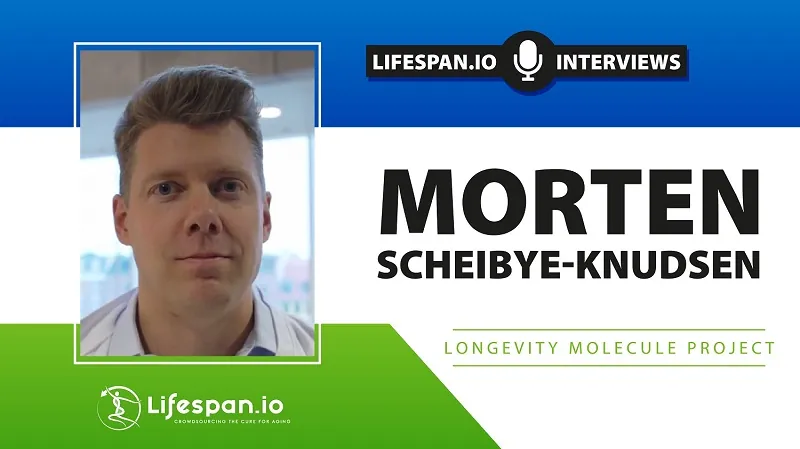Dr. Morten Schiebye-Knudsen is the founder of the Longevity Molecule Project funded by VitaDAO. However, this is just one side of his research. After starting his career as a physician in Denmark, he studied at the National Institute on Aging before founding the Scheibye-Knudsen Lab.
Thanks for joining us, Morten. Could you tell me a little bit about how you got into longevity research and your background?
I’m a medical doctor by background. I have an MD PhD from the University of Copenhagen, but even before medical school, I was interested in aging research and understanding why we get old and why we get sick when we get old.
I thought becoming a medical doctor would be a good angle on that, so I studied medicine, and then I worked as a physician for a little bit in Denmark and Greenland. After Greenland, I went to Baltimore in the United States, to the National Institute on Aging, where I really got into the research side of things. That’s where I really started to get into aging research.
After Baltimore, I went back to the University of Copenhagen and started my group. Now, I’m an Associate Professor at the University of Copenhagen, and I have a research group here, where we try to understand the molecular basis of aging and try to develop interventions for aging.
That is quite a career, to go from being a physician into the research side of things.
I think the good thing about my medical training was that I wanted to see my research proceed to human testing, and that’s not easy if you’re not a medical doctor. So, it’s been an almost 20-year dream to test interventions for humans, and now we’re finally doing clinical interventions. We have three clinical trials ongoing, and this is super exciting. Now we’re seeing if we can target aging. I think it is one of the most exciting developments in my career so far.
It’s very impressive. We touched on this a little before, but what was the motivation behind the research?
It is very similar to many people in the field. You see your parents and grandparents get old; my grandparents developed age-associated diseases. My grandma got Alzheimer’s. My granddad got Parkinson’s. That was tough, and later, my mom developed Alzheimer’s and my dad had Parkinson’s before he passed away. So, neurological aging has been very interesting for me.
I often wondered why we can’t treat these diseases. We can treat a lot of other diseases, but neurological diseases appear to be very, very difficult for us to treat. That’s a big challenge here, and the main issue here has been that we’ve maybe targeted the wrong processes.
The biggest risk factor for these diseases is aging, by far. If you get diabetes, you increase your risk of developing Alzheimer’s disease by 50%, but if you go from being 30 to being 80, you increase your risk of Alzheimer’s by 10,000%.
It’s different scales, and so understanding what happens in aging and why that drives diseases, I think is lacking. It’s something people take for granted when we age, but we don’t understand why.
Why do you think this is, and what can we do about it?
I think many people think that aging is a natural process, but I think it’s more. For me, I think the most important part to understand is that it’s a biological process. It occurs in different ways, in many different organisms.
We know that we can influence this biological process, and we can impact aging in most organisms where we tested it. It would be strange if we cannot do it in humans.
Will we be able to slow down or stop the aging process?
Yeah, I think so. For sure. I think it may take a long time before we can slow down the aging process. We are doing clinical tests (trials) right now using biomarkers of aging, but to completely stop aging, this will be a challenge. I don’t know when we’ll get to that stage, but there’s no law of nature that says that we have to age. There are organisms that don’t age. I think we’re going to be able to stop aging at some point, but maybe not in our lifetimes. That’s the unfortunate truth, but we’ll have to see, we’ll have to work hard, and maybe in a few generations.
Maybe. Could you tell me about the work of your lab and your team?
My lab uses different methodologies. We use computational approaches a lot and look at large data sets. This allows us to find potential interventions, then we can test these interventions in model organisms.
We use cells, fruit flies, mice, etc. We also started using fish for specific projects, and now we’re also testing humans. The whole purpose of the lab is to develop interventions, and sometimes you need to understand the process before you can develop an intervention.
Absolutely. How is the process to get to human clinical trials?
That depends on what it is. Because we can relatively easily go into clinical trials with behavioral interventions, like caloric restriction or using natural compounds. This is very easy to do in the sense that it’s feasible.
We also have a program where we are developing drugs, specific, completely new drugs. This takes a long time because you have to test them on mice, and then you have to make sure that they’re not toxic. Then you can test them in healthy humans, and then you can eventually get to a clinical trial with the target group.
Then we could also test FDA-approved drugs. So, we could refurbish or find a new indication for drugs that are already in the clinic. This is also quite feasible because there will already be the approvals to use it in humans, and there’s all the data on subjects and so forth.
How is the process going so far? Any significant steps? Milestones?
That depends on the project. We have projects in many phases right now. We have a drug in development with Insilico Medicine that looks really promising, particularly for age-associated neurodegeneration.
We also have some drugs in development with the DAO community that are crowd-funded, and I’ve been very fortunate to receive some funding from VitaDAO for the Longevity Molecule Project. We have potential drug candidates that could be used in clinical trials.
That’s impressive. Could you tell me a little more about that?
The VitaDAO project is very interesting. We’re fortunate to get access to the registries on pharmaceutical use; we have very good registries in Denmark. So, we have registries on people’s diagnoses, when they’re born, and when they die, which means that we can correlate the drugs that people are taking with their lifespans, for example.
We have a database of more than 1 billion prescriptions. It’s a huge database covering 5 million people. With the VitaDAO funding, we can test if drugs that are associated with longevity, based on the registries, affect signs of aging in cells.
We’ve tested a number of these compounds and found some potential hits that we are pursuing further, but this research always takes a little bit longer than you hope. You always want it to go very fast, and sometimes it takes a little bit more time, but I think we have some interesting possible candidates that could be pursued further.
This will, of course, also be up to the DAO community, which are the people that own the IP, the intellectual property from those compounds. This was sort of also an interesting adventure in itself.
Yes, it’s an interesting concept. How have you found working with DAO funding?
It’s been really interesting. I was contacted by the founders of Molecule, I think three, four years ago, when they were just starting up the Molecule platform with the idea that you could get a community and that community could get together and crowdfund the development of drugs so that individuals could then own a piece of the IP for that particular drug.
We had to talk a lot with my tech transfer office to persuade them that this was a good idea, but eventually we persuaded them and we set up a contract where the IP was owned by the VitaDAO (Molecule) team. We could then do the research, which was actually owned by Molecule, and then the rights of the IP were transferred via an non-fungible token.
There was an NFT created that contained the IP. I think this was the first example of an NFT that sort of contains the IP rights of biomedical research. That was interesting.
Yes, it’s a fascinating concept of how technology is getting involved with research and medicine.
Yes, it definitely is, I think allowing more flexibility of how research is funded and potentially how drug development takes place.
Would you say it’s more difficult to get funding in the traditional way or this way?
I think it’s very challenging in general to get funding. It’s a competitive landscape. There’s a lot of people that want funding and would like to get their research funded, so it’s always very competitive. I spend a lot of my time fundraising, writing grants, and trying to get more funding. I would say that working with the DAO is faster, whereas the traditional way usually takes a long time. With the DAO, you have a much more flexible process, which is good.
Absolutely. What’s the next steps for your project? Where’s it going?
The DAO project? I think the future is very exciting. In the next few weeks, we will decide on the next steps for the program. There are multiple directions that we could take. The exciting part is that these drugs, the FDA-approved ones, we could potentially very quickly go into a clinical trial with some of these compounds. This could be an exciting direction.
What kind of timeline would this be?
This could be within the next year. I think we have quite good facilities to do it. Within the next nine to twelve months, we could have finished a clinical trial with these compounds and see if we can attenuate aging through these compounds.
Wow, that’s quick! Wrapping up, what can you tell us about the future of longevity research? Where is it heading?
I think one of the most interesting aspects of aging research right now is the transition into clinical trials. This is happening in many places around the globe. I was at the International Institute on Aging, and I started there 14, 15 years ago. 20 years ago, they created a program called the Interventions Testing Program, which tests compounds on mouse lifespan in three different locations. The original idea of that program was to transition into clinical trials for humans. This has taken us more than 20 years to get to this point, but now we are here. I think this is really, really an exciting prospect.
Right now, I’m also organizing the next ARDD conference on aging research and drug discovery, ARDDX. At that conference, we’ll have a lot of speakers that are interested in what we now term as longevity medicine.
These are clinicians that are transitioning into the ultimate preventative medicine, which is not treating sickness but trying to maintain people’s health with age. I think this is a very exciting direction and something that will grow in the future.





